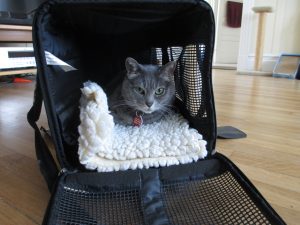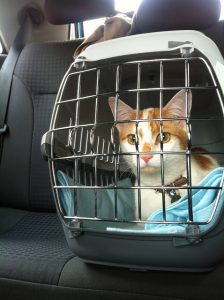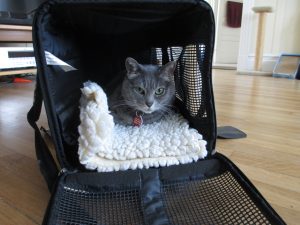For many cat owners, there’s nothing more stressful than getting their cat to the vet. And it’s not necessarily the vet visit the pet parent minds so much as getting their cat into the cat carrier. In one study, the stress of getting cats to the veterinarian was cited as a reason many people don’t EVEN BOTHER taking their cat to the doctor for a regular checkup.

Make one move toward the closet, or the garage door, perhaps you’re already sweating bullets…your cat picks up on the signs…and then before you know it, they have tucked themselves deeply underneath your bed, just out of reach. If you’re lucky, perhaps you can grab and pull out your cat without being bitten or scratched; some of you might even resort to scaring your cat out from under the bed with a broom or vacuum (I wish I was kidding, but all the above happen all too frequently). You might even have to just cancel that vet appointment at the last minute…
How did we get here? Why are so many people resorting to such heavy-handed, fear-inducing, traumatic methods to put a cat in a box (I thought cats loved boxes?). Methods that no doubt will make the whole process even harder next time around?
Yes! Cats can be trained!
The first challenge is the pervasive disbelief that we can train cats at all, much less train them to willingly go into a cat carrier. Second, is getting information on training techniques to cat owners so they can know where to start!
A new study tested the effects of a carrier training protocol on signs of stress in cats while being transported in a car and then examined in a veterinary office. The study, Carrier training cats reduces stress on transport to a veterinary practice, conducted at the University of Veterinary Medicine in Vienna, Austria, was recently published in the journal Applied Animal Behavior Science.
What the scientists did…
Researchers tested 22 cats. Each cat was individually taken into a new room and given 5 minutes to adjust. Next the carrier was placed on the floor and the cat was given 3 minutes to enter voluntarily, at which point they were placed in the carrier. All cats were given treats during the 10-minute car ride across campus to the veterinary exam. The cats were kept in a waiting room for 5 minutes, then brought into a separate room for an exam. Cats were given 3 minutes to exit the carrier on their own, at which point the carrier was dismantled and the examination was conducted in the bottom half of the cat carrier.
What did the training look like?

The cats were split into 2 groups, with half of the cats receiving “carrier training” which consisted of 7 steps. To summarize the steps:
- Presenting the cat with just the bottom half of the carrier, and giving the cats treats when they approach or get in the carrier; luring them closer to carrier with treats if they wouldn’t approach on their own
- Repeating step one with the top and door added, with the door open, rewarding any approach or entering, as well as any calm behavior in the carrier
- Moving and closing the door while the cat is inside, tossing treats into the carrier through the front door
- Picking up the carrier for short periods at first, gradually increasing the time the carrier is lifted with the cat secured inside, rewarding the cat for calm behavior
- Carrying the cat to the car, offering tuna while in the carrier in the car
- Turning on the engine, offering tuna
- Short car rides, gradually increasing the time in the car (up to 3 minutes), paired with food, petting and verbal praise
Each cat was given a total of 28 training sessions over the course of 6 weeks. Three of 11 cats made completed all seven stages, with six cats getting to stage 7 and two cats to stage 6. The control group of cats did not receive any type of training before the second veterinary exam, which was the next part of the study.
The researchers measured stress using the “Cat Stress Score,” a commonly used measure of feline behaviors and postures that suggest whether a cat is relaxed, tense or fearful. A camera was placed in the cat carrier to observe the cats’ behaviors during the car ride, and temperature, heart rate, and respiratory rate were measured during the vet exam. It was also noted whether cats entered their carriers willingly, whether they left the carrier by themselves during the exam, and whether they showed fearful or aggressive behaviors during the veterinary exam.

Results showed that all cats had a lowered stress score during the car ride to the second veterinary exam; but cats in the training group experienced a much larger reduction in stress scores. Cats in the training group were more likely to show behaviors such as kneading or rubbing against the carrier. Cats with carrier training were able to be examined more quickly, although they were not more likely to leave the carrier on their own.
Not all behaviors were affected by the training; for example, there were no differences between groups on any of the physiological measures of stress (respiratory rate, heart rate, temperature). There were also no differences between the two groups in stress scores during the time in the waiting room or during the exam. It should also be noted that even though the cats were randomized into either a training or control group, 7 out of 11 of the cats in the training group went into the carrier on their own right from the get-go, whereas only 4 of the cats in the control group did, suggested that there may have been some personality differences or different experiences or associations with carriers between the two groups. Finally, because the study used laboratory cats, we don’t yet know how precisely this would apply to cats in homes…is someone getting on that study???
But, THIS study does provide evidence for the power of positive training! With just a few weeks of short training sessions, cats showed less stress during a car ride in a carrier and were easier to examine by a veterinarian. Those sound like two major improvements for cats to me! If you need more advice on how to train YOUR cat to love their carrier, here are a few resources I like:
- icatcare: “How to train your cat to use a cat carrier“
- Sophia Yin: “Training cats to love their carriers“
- Catalyst Council: “Cats and carriers: Friends not foes“
Reference: Pratsch, L., Mohr, N., Palme, R., Rost, J., Troxler, J., & Arhant, C. (2018). Carrier training cats reduces stress on transport to a veterinary practice. Applied Animal Behaviour Science.
This blog post is part of the 2018 #Train4Rewards Blog Party. See what the fun is all about by clicking on the image below!




